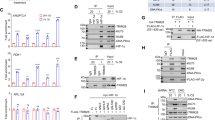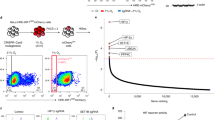Abstract
Expression of hypoxia-responsive genes is mediated by the heterodimeric transcription factor hypoxia-inducible factor-1 (HIF-1) in complex with the p300/CREB-binding protein (p300/CBP) transcriptional coactivator. The protein CITED2, which binds p300/CBP, is thought to be a negative regulator of HIF-1 transactivation. We show that the CITED2 transactivation domain (TAD) disrupts a complex of the HIF-1α C-terminal TAD (C-TAD) and the cysteine-histidine–rich 1 (CH1) domain of p300/CBP by binding CH1 with high affinity. The high-resolution solution structure of the CITED2 TAD–p300 CH1 complex shows that the CITED2 TAD, like the HIF-1α C-TAD, folds on a helical, Zn2+-containing CH1 scaffold. The CITED2 TAD binds a different, more extensive surface of CH1 than does the HIF-1α C-TAD. However, a conserved 'LPXL' sequence motif in CITED2 and HIF-1α interacts with an overlapping binding site on CH1. Mutation of the LPEL sequence in full-length CITED2 abolishes p300 binding in vivo. These findings reveal that CITED2 regulates HIF-1 by competing for a hot spot on the p300 CH1 domain.
This is a preview of subscription content, access via your institution
Access options
Subscribe to this journal
Receive 12 print issues and online access
$189.00 per year
only $15.75 per issue
Buy this article
- Purchase on Springer Link
- Instant access to full article PDF
Prices may be subject to local taxes which are calculated during checkout







Similar content being viewed by others
References
Semenza, G.L. Regulation of mammalian O2 homeostasis by hypoxia-inducible factor 1. Annu. Rev. Cell Dev. Biol. 15, 551–578 (1999).
Iyer, N.V. et al. Cellular and developmental control of O2 homeostasis by hypoxia-inducible factor 1α. Genes Dev. 12, 149–162 (1998).
Semenza, G.L. Hypoxia-inducible factor 1: oxygen homeostasis and disease pathophysiology. Trends Mol. Med. 7, 345–350 (2001).
Kung, A.L., Wang, S., Klco, J.M., Kaelin, W.G. & Livingston, D.M. Suppression of tumor growth through disruption of hypoxia-inducible transcription. Nat. Med. 6, 1335–1340 (2000).
Wang, G.L., Jiang, B.H., Rue, E.A. & Semenza, G.L. Hypoxia-inducible factor 1 is a basic-helix-loop-helix-PAS heterodimer regulated by cellular O2 tension. Proc. Natl. Acad. Sci. USA 92, 5510–5514 (1995).
Huang, L.E., Arany, Z., Livingston, D.M. & Bunn, H.F. Activation of hypoxia-inducible transcription factor depends primarily upon redox-sensitive stabilization of its α subunit. J. Biol. Chem. 271, 32253–32259 (1996).
Jiang, B.H., Rue, E., Wang, G.L., Roe, R. & Semenza, G.L. Dimerization, DNA binding, and transactivation properties of hypoxia-inducible factor 1. J. Biol. Chem. 271, 17771–17778 (1996).
Semenza, G.L. Physiology meets biophysics: visualizing the interaction of hypoxia-inducible factor 1α with p300 and CBP. Proc. Natl. Acad. Sci. USA 99, 11570–11572 (2002).
Bruick, R.K. & McKnight, S.L. Transcription. Oxygen sensing gets a second wind. Science 295, 807–808 (2002).
Lando, D., Peet, D.J., Whelan, D.A., Gorman, J.J. & Whitelaw, M.L. Asparagine hydroxylation of the HIF transactivation domain a hypoxic switch. Science 295, 858–861 (2002).
Mahon, P.C., Hirota, K. & Semenza, G.L. FIH-1: a novel protein that interacts with HIF-1α and VHL to mediate repression of HIF-1 transcriptional activity. Genes Dev. 15, 2675–2686 (2001).
Lando, D. et al. FIH-1 is an asparaginyl hydroxylase enzyme that regulates the transcriptional activity of hypoxia-inducible factor. Genes Dev. 16, 1466–1471 (2002).
Hewitson, K.S. et al. Hypoxia-inducible factor (HIF) asparagine hydroxylase is identical to factor inhibiting HIF (FIH) and is related to the cupin structural family. J. Biol. Chem. 277, 26351–26355 (2002).
McNeill, L.A. et al. Hypoxia-inducible factor asparaginyl hydroxylase (FIH-1) catalyses hydroxylation at the β-carbon of asparagine-803. Biochem. J. 367, 571–575 (2002).
Freedman, S.J. et al. Structural basis for recruitment of CBP/p300 by hypoxia-inducible factor-1α. Proc. Natl. Acad. Sci. USA 99, 5367–5372 (2002).
Dames, S.A., Martinez-Yamout, M., De Guzman, R.N., Dyson, H.J. & Wright, P.E. Structural basis for Hif-1 α/CBP recognition in the cellular hypoxic response. Proc. Natl. Acad. Sci. USA 99, 5271–5276 (2002).
Lee, C., Kim, S.J., Jeong, D.G., Lee, S.M. & Ryu, S.E. Structure of human FIH-1 reveals a unique active site pocket and interaction sites for HIF-1 and VHL. J. Biol. Chem. (2002).
Min, J.H. et al. Structure of an HIF-1α-pVHL complex: hydroxyproline recognition in signaling. Science 296, 1886–1889 (2002).
Hon, W.C. et al. Structural basis for the recognition of hydroxyproline in HIF-1α by pVHL. Nature 417, 975–978 (2002).
Dann, C.E. 3rd, Bruick, R.K. & Deisenhofer, J. Structure of factor-inhibiting hypoxia-inducible factor 1: an asparaginyl hydroxylase involved in the hypoxic response pathway. Proc. Natl. Acad. Sci. USA 99, 15351–15356 (2002).
Elkins, J.M. et al. Structure of factor-inhibiting hypoxia-inducible factor (HIF) reveals mechanism of oxidative modification of HIF-1α. J. Biol. Chem. 278, 1802–1806 (2003).
Braganca, J. et al. Human CREB-binding protein/p300-interacting transactivator with ED-rich tail (CITED) 4, a new member of the CITED family, functions as a co-activator for transcription factor AP-2. J. Biol. Chem. 277, 8559–8565 (2002).
Leung, M.K., Jones, T., Michels, C.L., Livingston, D.M. & Bhattacharya, S. Molecular cloning and chromosomal localization of the human CITED2 gene encoding p35srj/Mrg1. Genomics 61, 307–313 (1999).
Shioda, T., Fenner, M.H. & Isselbacher, K.J. msg1, a novel melanocyte-specific gene, encodes a nuclear protein and is associated with pigmentation. Proc. Natl Acad. Sci. USA 93, 12298–12303 (1996).
Sun, H.B., Zhu, Y.X., Yin, T., Sledge, G. & Yang, Y.C. MRG1, the product of a melanocyte-specific gene-related gene, is a cytokine-inducible transcription factor with transformation activity. Proc. Natl. Acad. Sci. USA 95, 13555–13560 (1998).
Yahata, T. et al. The MSG1 non-DNA-binding transactivator binds to the p300/CBP coactivators, enhancing their functional link to the Smad transcription factors. J. Biol. Chem. 275, 8825–8834 (2000).
Yahata, T. et al. Selective coactivation of estrogen-dependent transcription by CITED1 CBP/p300-binding protein. Genes Dev. 15, 2598–2612 (2001).
Bhattacharya, S. et al. Functional role of p35srj, a novel p300/CBP binding protein, during transactivation by HIF-1. Genes. Dev. 13, 64–75 (1999).
Yin, Z. et al. The essential role of Cited2, a negative regulator for HIF-1α, in heart development and neurulation. Proc. Natl. Acad. Sci. USA 99, 10488–10493 (2002).
Bamforth, S.D. et al. Cardiac malformations, adrenal agenesis, neural crest defects and exencephaly in mice lacking Cited2, a new Tfap2 co-activator. Nat. Genet. 29, 469–474 (2001).
Vo, N. & Goodman, R.H. CREB-binding protein and p300 in transcriptional regulation. J. Biol. Chem. 276, 13505–13508 (2001).
Lo Conte, L., Chothia, C. & Janin, J. The atomic structure of protein-protein recognition sites. J. Mol. Biol. 285, 2177–2198 (1999).
De Guzman, R.N., Liu, H.Y., Martinez-Yamout, M., Dyson, H.J. & Wright, P.E. Solution structure of the TAZ2 (CH3) domain of the transcriptional adaptor protein CBP. J. Mol. Biol. 303, 243–253 (2000).
Gu, J., Milligan, J. & Huang, L.E. Molecular mechanism of hypoxia-inducible factor 1α-p300 interaction. A leucine-rich interface regulated by a single cysteine. J. Biol. Chem. 276, 3550–3554 (2001).
Daniels, D.L., Eklof Spink, K. & Weis, W.I. β-catenin: molecular plasticity and drug design. Trends Biochem. Sci. 26, 672–678 (2001).
Dyson, H.J. & Wright, P.E. Coupling of folding and binding for unstructured proteins. Curr. Opin. Struct. Biol. 12, 54–60 (2002).
Neri, D., Szyperski, T., Otting, G., Senn, H. & Wuthrich, K. Stereospecific nuclear magnetic resonance assignments of the methyl groups of valine and leucine in the DNA-binding domain of the 434 repressor by biosynthetically directed fractional 13C labeling. Biochemistry 28, 7510–7516 (1989).
Matsuo, H. et al. Structure of translation factor eIF4E bound to m7GDP and interaction with 4E-binding protein. Nat. Struct. Biol. 4, 717–724 (1997).
Guntert, P., Dotsch, V., Wider, G. & Wuthrich, K. Processing of multi-dimensional NMR data with the new software PROSA. J. Biomol. NMR 2, 619–629 (1992).
Bartels, C., Xia, T.-H., Billeter, M., Guntert, P. & Wuthrich, K. The program XEASY for computer-supported NMR spectral analysis of biological macromolecules. J. Biomol. NMR 5, 1–10 (1995).
Cornilescu, G., Delaglio, F. & Bax, A. Protein backbone angle restraints from searching a database for chemical shift and sequence homology. J. Biomol. NMR 13, 289–302 (1999).
Guntert, P., Mumenthaler, C. & Wuthrich, K. Torsion angle dynamics for NMR structure calculation with the new program DYANA. J. Mol. Biol. 273, 283–298 (1997).
Nilges, M., Clore, G.M. & Gronenborn, A.M. Determination of three-dimensional structures of proteins from interproton distance data by dynamical simulated annealing from a random array of atoms. Circumventing problems associated with folding. FEBS Lett. 239, 129–136 (1988).
Brunger, A.T. A System for X-ray Crystallography and NMR, Version 3.1 (Yale Univ. Press, New Haven, Connecticut, 1992).
Laskowski, R.A., Rullmann, J.A., MacArthur, M.W., Kaptein, R. & Thornton, J.M. AQUA and PROCHECK-NMR: programs for checking the quality of protein structures solved by NMR. J. Biomol. NMR 8, 477–486 (1996).
Koradi, R., Billeter, M. & Wuthrich, K. MolMol: a program for display and analysis of macromolecular structures. J. Mol. Graph. 14, 51–55, 29–32 (1996).
Hoffman, R.C., Horvath, S.J. & Klevit, R.E. Structures of DNA-binding mutant zinc finger domains: implications for DNA binding. Protein Sci. 2, 951–965 (1993).
Acknowledgements
This work was supported in part by grants from the Dana-Farber Cancer Institute–Novartis Drug Discovery Program to M.J.E. and A.L.K., and a US National Science Foundation grant to G.W. M.J.E. is a recipient of a scholar award from the Leukemia and Lymphoma Society. S.J.F. is a recipient of a National Institutes of Health K08 award from the National Heart, Lung, and Blood Institute, and an ASH Scholar Award from the American Society of Hematology.
Author information
Authors and Affiliations
Corresponding author
Ethics declarations
Competing interests
The authors declare no competing financial interests.
Rights and permissions
About this article
Cite this article
Freedman, S., Sun, ZY., Kung, A. et al. Structural basis for negative regulation of hypoxia-inducible factor-1α by CITED2. Nat Struct Mol Biol 10, 504–512 (2003). https://doi.org/10.1038/nsb936
Received:
Accepted:
Published:
Issue Date:
DOI: https://doi.org/10.1038/nsb936
This article is cited by
-
Oxygen: viral friend or foe?
Virology Journal (2020)
-
Lysine acetyltransferases and lysine deacetylases as targets for cardiovascular disease
Nature Reviews Cardiology (2020)
-
Novel Point Mutations of CITED2 Gene Are Associated with Non-familial Congenital Heart Disease (CHD) in Sporadic Pediatric Patients
Applied Biochemistry and Biotechnology (2020)
-
Identification of duplicated Cited3 genes and their responses to hypoxic stress in blunt snout bream (Megalobrama amblycephala)
Fish Physiology and Biochemistry (2019)
-
Hypersensitive termination of the hypoxic response by a disordered protein switch
Nature (2017)



